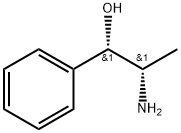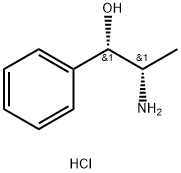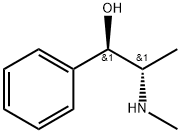CATHINE HYDROCHLORIDE
Synonym(s):(+)-Cathine;(+)-Pseudonorephedrine;(1S,2S)-2-Amino-1-phenyl-1-propanol;D-(+)-Norpseudoephedrine
- CAS NO.:492-39-7
- Empirical Formula: C9H13NO
- Molecular Weight: 151.21
- MDL number: MFCD00070245
- EINECS: 207-754-1
- SAFETY DATA SHEET (SDS)
- Update Date: 2023-06-08 09:02:12

What is CATHINE HYDROCHLORIDE?
The Uses of CATHINE HYDROCHLORIDE
An enantiomer of phenylpropanolamine and a metabolite of cathinone.
Definition
ChEBI: Cathine is an amphetamine that is propylbenzene substituted by a hydroxy group at position 1 and by an amino group at position 2 (the 1S,2S-stereoisomer). It has a role as a plant metabolite, a central nervous system stimulant and a psychotropic drug. It is a member of amphetamines and a phenethylamine alkaloid.
brand name
Adiposetten n;Amorphan depot;Andiposetten;Appetrol;Dietene;Exponcit;Insacial;Miniscap;Minusin depot;Mirapront n;Neo-soldana;Novese;Phyteia schlankheitsdragees;Reduform;Redufrom;Thinz.
World Health Organization (WHO)
Cathine, a sympathomimetic amine, was formerly widely available in proprietary anorexic preparations. As dependence can occur and abuse has been reported, cathine has recently (1986) been subjected to control under Schedule III of the 1971 Convention on Psychotropic Substances. (Reference: (UNCPS3) United Nations Convention on Psychotropic Substances (III), , , 1971)
Safety Profile
Poison by subcutaneous route.When heated to decomposition it emits toxic vapors ofNOx.
Properties of CATHINE HYDROCHLORIDE
| Melting point: | 77.5-78° |
| Boiling point: | 273.23°C (rough estimate) |
| alpha | 20546 +37.9° (c = 3 in methanol) |
| Density | 1.0406 (rough estimate) |
| refractive index | 1.5380 (estimate) |
| storage temp. | 2-8°C |
| solubility | H2O: ~20 mg/mL |
| form | solid |
| pka | 8.92(at 25℃) |
| color | white |
| optical activity | [α]/D +34.0±2.0°, c = 3.5 in ethanol |
| EPA Substance Registry System | Benzenemethanol, .alpha.-[(1S)-1-aminoethyl]-, (.alpha.S)- (492-39-7) |
Safety information for CATHINE HYDROCHLORIDE
| Signal word | Danger |
| Pictogram(s) |
 Skull and Crossbones Acute Toxicity GHS06 |
| GHS Hazard Statements |
H301:Acute toxicity,oral H315:Skin corrosion/irritation H319:Serious eye damage/eye irritation H335:Specific target organ toxicity, single exposure;Respiratory tract irritation |
| Precautionary Statement Codes |
P261:Avoid breathing dust/fume/gas/mist/vapours/spray. P301+P310:IF SWALLOWED: Immediately call a POISON CENTER or doctor/physician. P305+P351+P338:IF IN EYES: Rinse cautiously with water for several minutes. Remove contact lenses, if present and easy to do. Continuerinsing. |
Computed Descriptors for CATHINE HYDROCHLORIDE
Abamectin manufacturer
New Products
4-(Dimethylamino)tetrahydro-2H-pyran-4-carbonitrile 4-AMINO-TETRAHYDRO-PYRAN-4-CARBOXYLIC ACID 4-Aminotetrahydropyran-4-carbonitrile Hydrochloride (R)-3-Aminobutanenitrile Hydrochloride 4-AMINO-TETRAHYDRO-PYRAN-4-CARBOXYLIC ACID HCL 3-((Dimethylamino)methyl)-5-methylhexan-2-one oxalate 5-Bromo-2-nitropyridine Nimesulide BP Aceclofenac IP/BP/EP Diclofenac Sodium IP/BP/EP/USP Mefenamic Acid IP/BP/EP/USP Ornidazole IP Diclofenac Potassium SODIUM AAS SOLUTION ZINC AAS SOLUTION BUFFER SOLUTION PH 10.0(BORATE) GOOCH CRUCIBLE SINTERED AQUANIL 5 BERYLLIUM AAS SOLUTION Methylcobalamin (vitamin B12) SODIUM METHYL PARABEN SODIUM VALPROATE AMOXICILLIN (AMOXYCILLIN) TRIHYDRATE ACICLOVIRRelated products of tetrahydrofuran
You may like
-
 1-Methyl-6-oxo-1,6-dihydropyridazine-3-carbonitrile 98%View Details
1-Methyl-6-oxo-1,6-dihydropyridazine-3-carbonitrile 98%View Details
99903-60-3 -
 88491-46-7 98%View Details
88491-46-7 98%View Details
88491-46-7 -
 1823368-42-8 98%View Details
1823368-42-8 98%View Details
1823368-42-8 -
 1714107-48-8 5-Iodo-3-methyl-2-nitropyridine 98%View Details
1714107-48-8 5-Iodo-3-methyl-2-nitropyridine 98%View Details
1714107-48-8 -
 2-(3-(tert-butyl)phenoxy)-2-methylpropanoic acid 1307449-08-6 98%View Details
2-(3-(tert-butyl)phenoxy)-2-methylpropanoic acid 1307449-08-6 98%View Details
1307449-08-6 -
 Ethyl 3-(furan-2-yl)-3-hydroxypropanoate 25408-95-1 98%View Details
Ethyl 3-(furan-2-yl)-3-hydroxypropanoate 25408-95-1 98%View Details
25408-95-1 -
 2-Chloro-5-fluoro-1-methoxy-3-methylbenzene 98%View Details
2-Chloro-5-fluoro-1-methoxy-3-methylbenzene 98%View Details
1805639-70-6 -
 1784294-80-9 98%View Details
1784294-80-9 98%View Details
1784294-80-9



